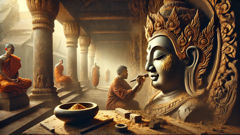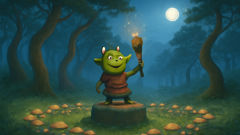Introduction
Beyond the river where the water lilies breathe at dusk and the mango trees spill their scent into the cooling air, there is a ridge that shelters an old temple. Its roofs are layered like the backs of great turtles, gilded edges catching last light, its threshold shadowed by towering statues whose eyes are set with colored glass. The people who live in the village beneath call those guardians yaksha, and they tell the names of them the way they tell the names of relatives: quietly, with a respect that settles in the bones. Yaksha are at once fearsome and familiar—giant-bodied, jewel-studded, sometimes horned, with mouths capable of laughter or of dreadful silence. They are keepers of thresholds, wardens of buried things, and mothers of old warnings. In the oldest stories they arrive without human ceremonies, emerging from the forest's deep and the caves where river-light turns mineral to song; in later tales they are woven into the calendar by priests and brought within temple walls to stand watch. This folktale travels the arc of that relationship—how yaksha shaped a kingdom's ethics, how a village learned to live with a guardian's appetite for order, and how a single oath between a boy and a guardian later taught an entire valley what it means to protect, to bargain, and to keep true the trust between mortal and spirit.
The Origins of the Yaksha
Legends change with the mouths that keep them, but the oldest songs of the valley say the yaksha were born of the world’s necessities—of the need to keep the unwanted from the campfire, of the need to mark the place where a road crossed a river and thieves might lurk. In those first stories the yaksha are not courtly figures nor static statues; they move like weather. In one tale they are ash-scented and earth-brown, stepping from a landslide after a storm opens the mountain like a book. In another, a yaksha gathers up the scattered teeth of an ancient dragon to line a temple’s foundation, giving the place an appetite for protection. The earliest villagers spoke of yaksha as more animal than god: temperamental, capricious, sometimes tricksy. They rewarded kindness, punished greed, and could be bargained with when the right offering was made.

Over generations, as the valley flourished and the governor's hall learned the craft of letters and law, yaksha settled into a new role. Priests carved them in wood and stone, fitting them to thresholds and shrine rooms. In temple art they gained ornament—the jeweled belt, the upturned moustache, the crown patterned like lotus petals. With human hands shaping their faces, the yaksha's nature was rewritten into something more formal and more useful to those who wished for order. They became an emblem: a visible declaration that a place had rules, that treasures were guarded by forces not measured in coin. Yet even in stone, the old stories stalked them. Carvers would leave a small crooked tooth unpolished, or a cheek-line unfinished, because the belief persisted that a little imperfection honored the yaksha's older, wilder origins and kept them unsettled enough to remain vigilant.
This shift from roaming spirit to temple sentinel carried with it rituals and laws. Monks choreographed the offerings and taught the village the songs that would still the yaksha's appetite for fresh souls. Offerings were not always gold; sometimes they were the things that opened a doorway to trust: bread baked by a grandmother's hands, a cloth dyed with river-mud patterns, a comb used long enough to hold a woman's rhythm. These small, human things had strange power. Yaksha, the priests would say, love the texture of ordinary life because they are not only guardians of treasure—they are guardians of thresholds where life must be honored. Their judgments were never merely punitive. If a woman returned a lost coin to its owner and laid it at the feet of a yaksha, the spirit honored the return with weather that favored harvest. If a man stole rice from a neighbor and offered a gilded bracelet to the yaksha in apology, the village would learn of the theft in sudden crowsong or a flooded path that revealed the trampled grain. Balance was what the yaksha enforced; greed unmasked itself in the wrong season.
But the yaksha also had long memories. They kept the names of rivers and ruined villages. They could remember slights and neglect across generations, and for that reason their altars required tending. The temples grew into places where the living and the spirit-bound traded memory. Priests recorded certain pacts in ink and lacquer: when the elders of a village promised to keep a forest as a common, the yaksha would keep thieves from that forest. When a merchant vowed not to sell sacred relics to strangers at the port, the yaksha would tilt the weather or turn a ship's cargo into heavy, worthless reed. These bargains read like maps of social trust; they were legal as much as they were holy, and the yaksha, though impossible to command, proved themselves steady lawgivers when the people upheld their side of the covenant.
It is easy to speak of yaksha as static beings, of course, but their stories are full of private humor and small cruelties that humanize them. A yaksha once simply moved the fence of a miser's garden so that his prized mangoes ripened against the public path where children could steal them without shame. In another tale a guardian folded its massive hands and refused to allow a boastful man inside the temple until he had walked the valley and apologized to all those he had scorned. Such acts served the village as both correction and lesson, making the yaksha less an arbitrary monster and more a teacher disguised as a force of nature. They do not reward flaunting wealth; they respect the patience behind patience, the accumulation that begins with honest labor, and the humility that recognizes dependence on the land and each other.
Because of that, the villagers cultivated a language of offerings that made sense to the yaksha. There were seasons when the shrine received colorful cloths and sugarcane for the strong months of harvest, and there were quiet, personal days when a child left an ink-stained scrap of paper at a yaksha's feet with a single, clumsy drawing. The yaksha read all these tokens in the way a seasoned judge reads testimony: with attention to the heart behind the act. And in such reading, they often acted to steady the precarious lives around them—guiding a lost traveler to the bridge, restraining a sudden flood with a mound of stone left where an elder prayed, ridding the granary of a rat that had eaten too many weeks of grain. These are small, everyday miracles in the oral accounts, but they accumulated into the sense that a guardian watched the village as a family might watch a child: not without strictness, and not without the occasional, inexplicable favor.
The yaksha's appetite for order could be terrifying, too. In the coldest retellings of the old songs, a greedy lord once tried to dig beneath the temple to steal a relic rumored to make men immune to wounds. The ground opened where he struck a shaft; a yaksha's fist burst upward like a black tree and seized the man, holding him in the earth until his men begged the priest to release him. The price: the man had to hand over his lands for the common good, fund the repair of flood defenses, and publicly fast every year until the crops returned. In that way, yaksha justice could be exacting but oddly restorative: punishment aimed at healing the opening that greed had created instead of mere revenge. Those kinds of stories did much to shape how the valley governed itself. The law bent toward balance and restitution rather than permanent exclusion, and in doing so, the community learned to think of guardianship not only as protection of objects but as stewardship of relationships.
As temples grew large and trade routes thickened with merchants, yaksha of the greatest renown took on personalities and names in the way heroes do. One such guardian, called Phaya Krom, was said to have a laugh like rolling thunder. He loved riddles, exchanged insults with traveling monks, and would sometimes relocate a child's lost buffalo to the rice plain where the child would find it at sunrise. Another yaksha, Nelai, wore a crown of shells and kept the salt marshes at bay; she taught the villagers how to make the brine for fish preserving, and her altar accepted only offerings that had been prepared with hands that knew the tides. These named yaksha became anchors in the folk calendar: people lined up to ask favors at their altars, and storytellers used their deeds as parables to teach values. In the shadowed spaces between myth and habit, the yaksha shaped not only the physical but the ethical landscape of the valley, and the villagers, in turn, made daily practices that remembered both the terrors and the tenderness of those guardians.
The Guardians' Code and the Village of Ban Phon
Ban Phon was a village that rose against the gentle slope of the eastern ridge, where daybreak touched the temple's gilded edges first. People said Ban Phon's particular yaksha were temperate compared to those of other valleys: not fond of storms, but precise in their demands. The village's founding myth tells how, three generations before the current elders, a drought threatened the seed rice. It was then that a traveler arrived—dry and dusty, with a trunk full of old maps and a voice that smelled of the sea. He carried a statue, small and cradled in cloth: a yaksha carved from a single basalt stone, its eyes inlaid with lapis and its hands folded as if in waiting. The traveler said the statue had been uprooted from a temple at the mouth of a forgotten river and that wherever it went, a pattern of order seemed to follow: paths were cleared, lost things returned, and trade prospered. The elders of Ban Phon made a desperate pact. They promised to care for the statue, place it on a plinth beneath the temple eave, and keep a measure of their rice aside each season for the temple stores. In exchange, the yaksha would favor their fields with timely rains. They won their bargain.

But bargains with yaksha are never simple contracts written on paper. They are woven, living agreements that require ceremony and attention. The village learned quickly that ritual mistakes mattered. Once, a group of young men in a flush of prosperity offered a garland woven from silk that had been dyed with a merchant's imported dye—bright and shamelessly expensive. The yaksha, who respected honest work over flaunted wealth, refused the offering and turned the market's cartwheels silent for a week, as though a small wind had folded into the village and refused to move. Business slowed, and the young men learned to weave the next garland from the island reeds that grew by the riverbank, dyeing it with turmeric and the juice of tamarind as their grandmothers had taught. That offering the yaksha accepted with a slow nod like a judge's satisfied pause. The lesson—humility over display—stitched itself into Ban Phon's practice.
Daily life at Ban Phon, as in many villages that walk the borders between the human and the spirit, became an exercise in reciprocal attention. Mothers who fed the poor left a bowl of rice at the yaksha's foot before dawn; fishermen who found a child onboard a drifting skiff returned the child and brought an offering of salted fish; elders taught children the correct tone of voice for a petition. Those tones matter. A plea spoken as a demand will put a yaksha's temper to flame; a humble, grateful tone invites curiosity and favors. Stories collected at the temple reveal that the yaksha like to test character with small, domestic trials: a straw hut that will shed its roof cruelly in a storm if someone has been cruel to their neighbor, or a neighbor's water buffalo that will wander into the right field if the owner shares his grain. Many of these actions sound petty to the foreign ear, but to the community they are the mechanisms of moral education, subtle forces that create incentives for fairness in a world where written law was scarce.
Among the villagers of Ban Phon there was a young boy named Saen, curious and quick-tongued, who formed a secret friendship with the basalt yaksha. Saen's mother milled rice for a living; the work was steady but never rich. Saen spent his afternoons at the temple grounds, watching the monks sweep the courtyard and the merchants pass with baskets of dried fish. He began to notice patterns: the yaksha's eyes seemed to track the path of children who learned to share, and there were nights when Saen swore he heard the statue's stone face shift in the prayer light. At first it was a flicker, a small sound, but over months the statue seemed to offer him tiny things: a smooth pebble placed at his feet, the return of a lost thread, a momentary gust that redirected his paper boat away from a stubborn eddy. Saen interpreted these as favors granted to an honest boy; he in turn began to practice the habits the yaksha liked most—returning lost things, helping his mother in the mill, listening to the elders' stories.
The true test of Saen's apprenticeship came when a foreign trader arrived—a man with a loud tongue and a bag of dazzling metal pieces. The trader claimed a relic in the temple's storage: a carved amulet reputed to hold the blessing of a long-departed chieftain. He offered the elders a handsome price, enough to secure roofs and seed for a decade. The village council, tempted by the promise of sudden relief, debated in low voices until dusk. Sell it, argued some, and we can rebuild. Keep it, argued others, and keep trust with the yaksha. Saen watched from the shadows, feeling as if he stood at the center of the world's balance. In the end, the elders divided: some wanted to sell a portion of the temple's minor ritual objects while keeping the amulet, but their indecision upset the ambient order. That night, an unusual wind moved through Ban Phon. The lamps guttered, and the trader's steed broke its tether and bolted, scattering the cart. The next morning, footprints—deep and enormous—marked the riverbank where the trader had planned to take the amulet to auction. It was as if the valley itself had registered their tremor of choice and responded with a reminder.
When the council realized the gravity of what they almost did, they turned to Saen for counsel. His answer was simple and full of the small wisdom he had learned from keeping the yaksha's favors: "We cannot trade the thing that teaches us to be careful. We can trade what we have too much of." The villagers agreed to sell a chest of old bronze ceremonial bells—objects of limited ritual power but good coinage—and used the proceeds to fix roofs and repair the irrigation dikes. The trader, whose fingers itched for immediate gain, left with the bells and without the amulet. The yaksha accepted the exchange with what the villagers described as a satisfied stone-breath; the river late that season gave them rain, and the fields, patched and tended, yielded steady grain.
That exchange became a moral tale that spread to neighboring valleys. It taught the practical lesson that not all wealth is fungible; some things store more than material value. The yaksha's role, as the villagers told it, was not to hoard relics but to prevent the community from unwise trades that would break social bonds. Through such stories, the yaksha's code—protector of thresholds, assessor of intent, enforcer of restitution—became a kind of civic ethic in Ban Phon. People learned that offerings mattered, that humility was sovereign, and that relationships between human and spirit were maintained by reciprocal acts rather than by fear alone.
Years later, Saen grew into a man who knew how to mend the long ropes of social trust. He taught children how to weave garlands from river reeds, instructing them that each knot remembered a neighbor's name. He kept a ledger—not of coin, but of favors owed and returned, a system that sounded whimsical but proved effective in seasonal shortages. When the monastery faced a plague of beetles that ate the roof thatch, it was Saen's idea to convene a night of shared labor; the yaksha accepted their combined sweat and salt, and the beetles mysteriously vanished. People said Saen had learned to speak the yaksha's language: not a tongue of words but a grammar of action. In that way a single boy and a small basalt statue taught a whole village how to balance need and abundance, how to make bargains that restored rather than destroyed, and how the presence of a guardian spirit could shape a community's moral architecture.
The story of Ban Phon is not unique; across the land, villages adapt yaksha lore to their local needs, creating a network of rituals and customs that bind people to place. In the telling and retelling, the yaksha shift shape and emphasis—sometimes harsher, sometimes more tender—but the throughline remains: these guardians encourage a life where the thresholds between people and between people and the land are tended, where gifts and obligations move in measured cycles, and where the existence of a watching presence refines human choices toward the common good. The Yaksha Kingdom, then, is not an empire of stone alone; it is the living covenant between a people and the unseen forces that teach them the costs and rewards of living together.
Conclusion
The Tale of the Yaksha Kingdom is not simply a catalogue of marvels or a record of odd things that happen near temples; it is a living archive of how humans and spirits learned to share a fragile world. The yaksha, in these stories, serve a deeper purpose than sentinel or scarecrow: they are social engineers of a sacred sort, guardians of reciprocity. When a village leaves its offerings at a guardian's feet, when it patches its dikes after a season of comfort, when a young boy chooses to return a lost coin instead of hiding it, all of these small acts resonate into the larger geometry of trust that the yaksha both watch and help form. The myths remind us that protection demands participation; that to keep a temple safe is also to keep the village honest; that to name a guardian is to enter a relationship that asks for attention and returns wisdom. In modern times, tourist maps point to statues and gilded gates, and visitors take photographs of painted faces that gleam like the edges of old coins, but if one listens, beyond the shutters of commerce, the elders still hum the old songs and children still learn the correct tone for petitions. These are living lessons about stewardship, about a balance between human hunger and communal need, and about how, in an ancient valley, the presence of a watching spirit helped a people learn the art of being careful with one another. The yaksha do not make the rules for us, but their stories have shaped the kind of people who follow them: people who understand that thresholds matter, that offerings are language, and that in protecting what is worth protecting, a community finally protects itself.













